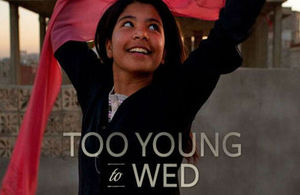Mark Mallalieu Op-ed on Child marriage
The Head of DFID Afghanistan wrote the following article ahead of the Girl Summit 2014 which took place in London on 22nd July.

Too young to wed
In most cultures marriage is an important rite of passage. Kabul’s beautiful wedding halls demonstrate its great significance in Afghan society. Visit a village in England on a Saturday and you are likely to hear wedding bells ringing in a local church. Quite rightly, weddings are joyous occasions.
But what happens when a wedding does not take place between two consenting adults? What happens when one of the people getting married is a child?
Child marriage is a serious problem across the globe. According to UN estimates, some 11% of young women in developing countries entered into marriage before they were 15. Overall this figure seems to be falling compared to a generation ago. But it is still much too high.
Afghan civil law states that the minimum age for marriage is 16 for girls and 18 for boys. Islam holds that marriage should be entered into with a full knowledge of what it involves. In practice this is not always the case. In Afghanistan, around 15% of girls are estimated to be married before the age of 15.
There are many reasons why child marriage is harmful. Firstly, it is bad for girls’ health. Pregnancy damages young bodies: pregnancy-related complications are a major cause of death amongst 15-19 year olds. Because teenage mothers are not yet physically mature, their babies are also more likely to be stillborn or to die in the first weeks of their infancy. Those that do survive are often smaller and may be physically disadvantaged throughout their lives.
Secondly, marriage robs children of their childhood. Most children, particularly girls, stop going to school, which in turn limits their opportunities in life including their options for improving their household’s standard of living. The children of uneducated mothers are less likely to go to school, reducing their chances of getting a skilled job and trapping them in poverty.
The British Prime Minister and UNICEF co-hosted the 2014 Girl Summit in London on 22nd July 2014, with the goal of mobilising a global effort to bring an end to child and early forced marriage. At the event, governments, NGOs, faith leaders and young people met together to share their experiences and discussed what works in tackling child marriage. The Summit raised awareness of the problems of child marriage and encouraged leaders to commit to change. Here in Kabul, NGOs, government officials and academics also met together to discuss the same issues.
Right now we know that the factors which lead to child marriage are complex and interconnected. They include poverty, a lack of education, and social expectations and pressures. Ending child marriage will always involve addressing these root causes.
Education is one of the most powerful tools available. Simply by being in school, a girl is more likely to be seen as a child. Schools also provide girls with knowledge, skills, and social networks that help to raise the aspirations of both the child and her parents. Projects such as DFID’s Girls Education Challenge concentrate on getting children into school and keeping them there. I am proud that the UK is a leading supporter of girls’ education in Afghanistan through this project, working in close partnership with the Ministry of Education.
Right now, global attention is turning to the issue of Child Marriage. We have the opportunity to help to make a brighter future for girls. Girls themselves must be at the centre of this action - they are the ones whose rights and lives are at stake. But all of us must play our part.